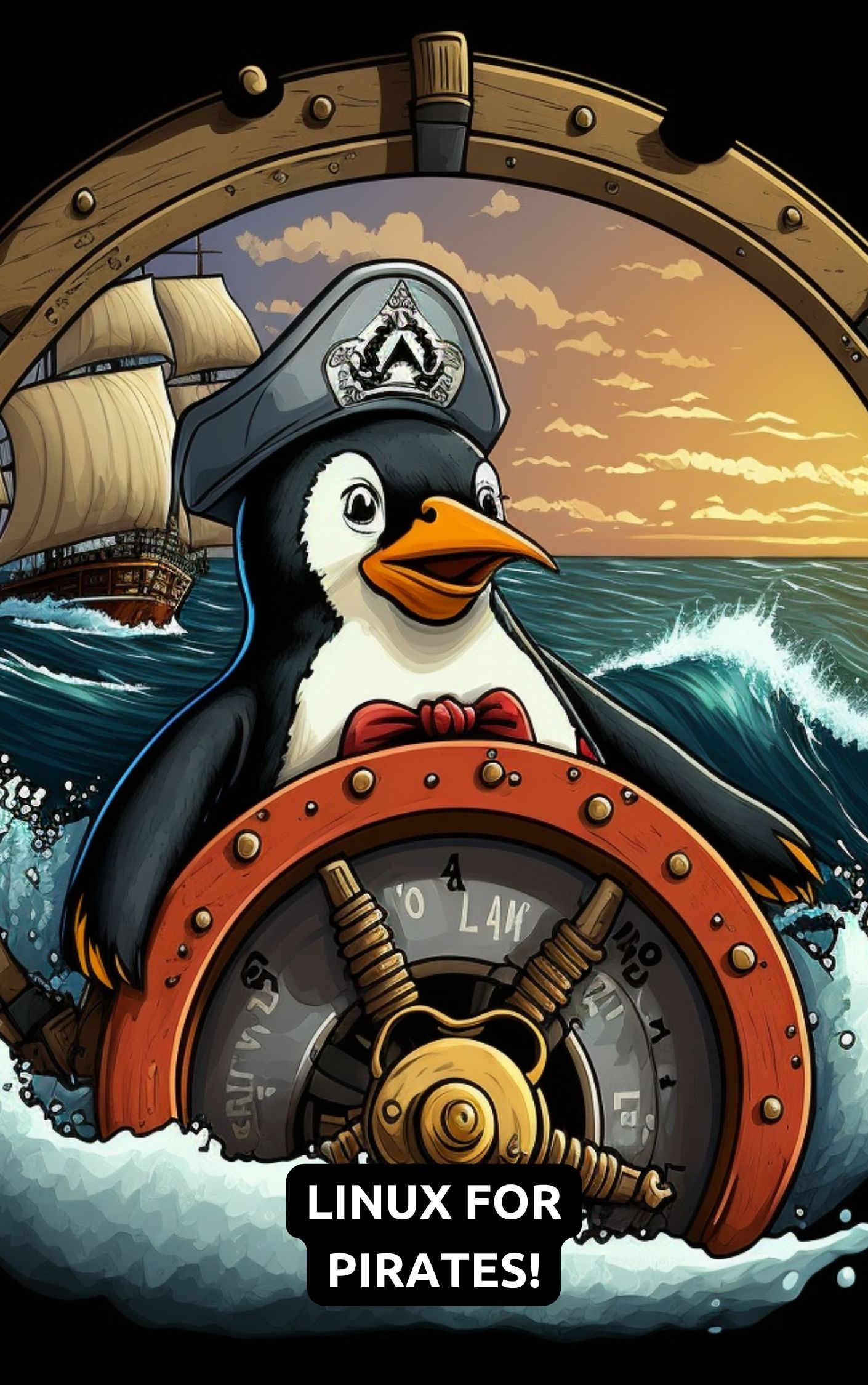linux-for-pirates

| By Dean Lofts | GitHub |
In memory of Aaron Swartz
The Internet’s Own Boy: The Story of Aaron Swartz
Note This is a must watch documentary.

Aaron Swartz was a computer programmer, entrepreneur, and internet activist who made significant contributions to the development of the internet and the open access movement.
Aaron was born in 1986, and became interested in computers and the internet at a young age. He was a brilliant and talented programmer, and was known for his ability to quickly grasp and master new technologies. He co-authored the RSS 1.0 specification at the age of 14, and went on to work on a variety of other projects, including the development of the Creative Commons license, the building of the first consumer web feed platform, and the creation of the social news site Reddit.

Aaron was also a strong advocate for open access, which is the movement to make knowledge and information freely available to all, rather than being locked behind paywalls and controlled by a few powerful corporations or institutions. He believed that access to knowledge and information was a fundamental right, and that it should be freely available to everyone.
Aaron’s work had a major impact on the development of the internet and the open access movement, and he is remembered as a pioneer and a hero by many in the tech community. Tragically, Aaron took his own life in 2013, at the age of 26. His legacy lives on through the work of those who continue to fight for open access and the free flow of information. Arrr!
What is the Linux kernel?
The Linux kernel is the core component of the Linux operating system. It is a piece of software that acts as an interface between the hardware and the rest of the operating system, and is responsible for managing the resources of the computer and allocating them to the various applications and processes that are running.
The Linux kernel was originally developed by Linus Torvalds in 1991, and was released as open source software under the GNU General Public License. It is written in the C programming language, and is available for a wide variety of computer architectures, including x86, ARM, and PowerPC.
Linus Torvalds

Linus Torvalds is the creator of the Linux operating system. He is a computer science student at the University of Helsinki in Finland, and was interested in creating an operating system that would be more flexible and open than the proprietary operating systems that were available.
Richard Stallman

Richard Stallman is the creator of the GNU operating system. He is a computer science student at the Massachusetts Institute of Technology (MIT), and was interested in creating an operating system that would be more flexible and open than the proprietary operating systems that were available.

Before we begin
Loftwah stood at the helm of his ship, staring out at the vast expanse of the ocean. He had been a pirate for as long as he could remember, and he loved nothing more than the thrill of the hunt and the rush of adrenaline that came with finding treasure.
But Loftwah was no ordinary pirate. He was a master of technology, using his advanced gadgets and devices to outsmart his enemies and outmaneuver them on the high seas. “Any sufficiently advanced technology is equivalent to magic,” he thought to himself, smiling at the thought of all the treasure he had acquired through his clever use of technology.
But even Loftwah knew that technology was not always the answer. He had learned the hard way that “social engineering bypasses all technologies, including firewalls.” He had lost more than one treasure to clever pirates who used their charm and charisma to manipulate him and his crew.
Loftwah was not one to accept defeat easily, though. “People said I should accept the world. Bullshit! I don’t accept the world,” he thought, determined to find a way to outsmart even the most clever of his rivals.
And so he set his sights on the greatest treasure of them all: the fabled Black Pearl, a ship that was said to be filled with unimaginable riches. Loftwah knew that he couldn’t do it alone, though. He needed a crew of skilled pirates who were just as determined and clever as he was.
As he searched for the perfect crewmates, Loftwah couldn’t help but think about the dangers of relying too much on technology. “The real danger is not that computers will begin to think like men, but that men will begin to think like computers,” he thought, knowing that it was important to keep a balance between using technology and using one’s own intelligence and creativity.
Finally, Loftwah found the perfect crew. They were a diverse group, each with their own unique skills and talents. Together, they set off on their quest for the Black Pearl, using all of their combined knowledge and expertise to outsmart their enemies and navigate the dangerous waters.
As they sailed closer and closer to their goal, Loftwah couldn’t help but feel a sense of excitement and determination. “Patience, persistence and perspiration make an unbeatable combination for success,” he thought, knowing that they would stop at nothing to claim the treasure that was rightfully theirs.
And in the end, their hard work paid off. They found the Black Pearl, and it was even more magnificent than they had imagined. “It doesn’t matter what you know, what matters is when you know,” Loftwah thought as he gazed at the treasure-filled ship, knowing that their knowledge and skills had been key to their success.
As they sailed back home, filled with treasure and stories to tell, Loftwah couldn’t help but feel grateful for the diverse and skilled crew that he had assembled. He knew that it was their combined knowledge and creativity that had led them to victory, and he couldn’t wait to see what other adventures they would have together in the future.
About the author (This isn’t on the test)

Once upon a time, in the golden age of piracy, there lived a fearless pirate by the name of Dean (Loftwah) Lofts. Loftwah was a notorious buccaneer, known throughout the seven seas for their technical expertise and programming prowess.
Loftwah commanded a fearsome crew of pirates, who sailed the high seas in search of treasure and adventure. They were a motley crew, made up of scallywags, scoundrels, and ne’er-do-wells from every corner of the globe, including the wild and untamed shores of Australia.
Together, Loftwah and their crew roamed the Caribbean, plundering and pillaging their way from island to island. They braved fierce storms and battled fierce foes, always coming out on top thanks to Loftwah’s quick wit and sharp sword, as well as their formidable knowledge of Bash, PHP, Python, Ruby, HTML, JavaScript, and other programming languages.
One day, Loftwah and the crew set their sights on a rich Spanish galleon, loaded down with gold and jewels. They crept up on the ship under cover of darkness, and with a mighty roar, they boarded the vessel and took control.
The Spanish crew fought bravely, but they were no match for the fierce pirates led by Loftwah. In the end, Loftwah and their crew emerged victorious, the galleon was theirs for the taking.
As they sailed off into the sunset with their prize, Loftwah raised their fist to the sky and let out a mighty “YARGH!” It was a good day to be a pirate.
So if you ever find yourself sailing the high seas and you see a pirate flag with a Loftwah-shaped skull and crossbones on it, beware! You’re in for a wild ride with the fearless Loftwah and their trusty crew. Ahoy, matey!
Chapter One - Getting Started

Avast ye, landlubbers! Linux be a free and open-source operating system that be runnin’ on the Linux kernel, a core component o’ the operating system. It be used in a variety o’ devices, from desktops to servers to smartphones to embedded systems.
There be many reasons why a scurvy dog might want to set sail with Linux, including:
-
It be free and open-source: Linux be freely available to all who be wantin’ to use it, and the source code be open for all to study, modify, and distribute.
-
It be highly customisable: Linux allows users to customise almost every aspect o’ the operating system, from the desktop environment to the window manager to the system utilities.
-
It be stable and reliable: Linux be known for its stability and reliability, and it be often used in mission-critical systems where uptime be crucial.
-
It has a large user community: Linux has a large and active user community, which means there be a wealth o’ knowledge and support available online.
-
It be secure: Linux be generally considered to be more secure than other operating systems, as it be less vulnerable to malware and other security threats.
-
It has a wide range o’ software available: Linux has a huge repository o’ free and open-source software available, from office applications to media players to games.
All in all, Linux be a versatile and powerful operating system that be suitable for a wide range o’ uses. Whether ye be a greenhorn or an experienced swashbuckler, Linux has something to offer for all.
Where to go from here?
Aye, matey! If ye be interested in pursuin’ a career in the field o’ Linux, there be several steps ye can take to get started:
Gain a solid understanding of the Linux operating system: To be successful in a Linux-related career, it be important to have a strong understanding of the Linux operating system and its various components, including the kernel, shell, and system libraries. Ye can gain this understanding through online courses, books, or hands-on experience using Linux on yer own computer or in a virtual machine.
Build up yer skills and knowledge: There be many different areas in which ye can specialize within the Linux field, such as system administration, network engineering, or software development. To increase yer chances of landin’ a job in one o’ these areas, it be important to build up yer skills and knowledge in the specific technologies and tools that be used in that field. This might include learnin’ programming languages, masterin’ command-line utilities, or becomin’ familiar with different Linux distributions.
Get certified: Many employers look for candidates who have formal certification in Linux or related technologies. There be several organizations that offer Linux certification exams, such as the Linux Professional Institute (LPI) and the Red Hat Certified Engineer (RHCE) program. Earning a certification can demonstrate yer expertise and commitment to the field, and can make ye a more competitive job candidate.
Network and build relationships: Networkin’ and building relationships with others in the Linux community can be a valuable way to learn about job openings and get yer foot in the door at companies that be hirin’. Attend local meetups, participate in online forums and discussion groups, and consider joinin’ a Linux user group or professional association.
Look for entry-level positions: If ye be just startin’ out in yer Linux career, it might be helpful to look for entry-level positions that can provide ye with the opportunity to gain hands-on experience and build up yer skills. These might include internships, junior-level system administrator positions, or entry-level software development roles. As ye gain experience, ye can then look for more advanced positions that align with yer career goals.
-
freeCodeCamp be a non-profit organisation that be dedicated to helpin’ people learn to code for free. It be run by a community o’ volunteers, and it be supported by donations from the community.
-
The Odin Project be a free online curriculum that be designed to teach web development. It be run by a community o’ volunteers, and it be supported by donations from the community.
Chapter Two - The Fundamentals

Ahoy mateys! If ye be lookin’ to set sail on the Linux sea, here be some things ye’ll need to know:
Learn the command line: The command line be the primary way to interact with a Linux system, so it be important to learn the basic commands and how to navigate the file system.
Understand file permissions: In Linux, each file and directory be owned by a specific user and group, and have permissions that control who can read, write, or execute them. It be important to understand how to set and manage these permissions.
Install and manage software: In Linux, software be installed and managed using package managers like apt or yum. Ye’ll need to learn how to use these tools to install and update software on yer system.
Work with users and groups: In Linux, users and groups be used to control access to resources on the system. Ye’ll need to learn how to create and manage users and groups, and how to set up user accounts and permissions.
Customize yer system: Linux be highly customizable, and ye can tweak yer system to suit yer needs and preferences. Ye’ll need to learn how to customize yer system’s settings, install and configure desktop environments, and more.
VS Code
| VS Code Website | Awesome VS Code |
Arr matey, ye be askin’ about Visual Studio Code, a popular and powerful code editor that be makin’ it easier for ye to write, debug, and collaborate on code.
VS Code be packin’ a lot of useful features for developers, such as syntax highlighting, code completion, and built-in support for version control systems like Git. Ye can also extend VS Code with plugins and extensions to add even more functionality, such as debugging tools, linting, and code formatting.
To work with VS Code, ye simply need to open up the editor and start writin’ or editin’ your code. Ye can also use the integrated terminal to run command-line tools, such as compilers or test runners.
VS Code be available on a variety of platforms, including Windows, Mac, and Linux, so ye can use it on the operating system of your choosin’.
So there ye have it, a brief overview of Visual Studio Code and how ye might be usin’ it as a developer. I hope this be helpin’ ye to understand this powerful code editor and all that it be capable of. Ahoy!
Python:
python3 -m http.server
This command will start a web server using Python’s built-in http.server module. No additional dependencies are required.
Node.js:
npx http-server
This command will start a web server using the http-server package, which can be installed by running npm install -g http-server.
Ruby:
ruby -run -ehttpd . -p8000
This command will start a web server using Ruby’s built-in WEBrick library. No additional dependencies are required.
PHP:
php -S localhost:8000
This command will start a web server using PHP’s built-in development server. No additional dependencies are required.
Go:
go run $(go env GOPATH)/src/github.com/golang/example/outyet/main.go
This command will start a web server using the Go programming language. To install Go on Ubuntu run the following:
sudo apt-get install golang -y
Cloudflare
Cloudflare is a content delivery network (CDN) and DNS service that can be used to improve the performance and security of a website. It does this by caching content on its global network of servers, which can help to reduce the load on the origin server. It also provides a number of security features, such as DDoS protection, bot management, and TLS encryption.
Ahoy, matey! For Cloudflare, ye should be well-versed in the ways of the web. This means having a strong understanding of how to use Cloudflare’s various services to protect and optimize websites.
Ye should be able to set up and configure Cloudflare’s services such as its content delivery network (CDN), DDoS protection, and SSL/TLS certificates. Ye should also be familiar with Cloudflare’s Web Application Firewall (WAF) and know how to use it to protect websites from malicious traffic and attacks.
In addition to these technical skills, it be important for ye to be able to communicate with clients and stakeholders about the benefits of using Cloudflare. Ye should be able to explain how Cloudflare can improve website performance, security, and reliability in a way that is easy for non-technical folks to understand.
Finally, as a true Cloudflare professional, ye should be able to keep yer head in a crisis and be able to think on yer feet. Whether it be dealing with a sudden influx of traffic to a client’s website or a network outage, ye should be able to think quickly and come up with solutions to keep yer ship sailing smoothly. So hoist the mainsail and get to work, matey!
eBPF
eBPF (extended Berkeley Packet Filter) is a technology that allows for the dynamic insertion of BPF programs into the Linux kernel at various hook points. It allows for the creation of powerful, flexible, and efficient tracing and monitoring tools, as well as the ability to write custom kernel modules without having to write any C code.
In a pirate theme, you could think of eBPF as a way to add new features to your ship (the Linux kernel). Instead of having to modify the ship’s hull (the Linux kernel) to add new features, eBPF allows you to add new features by inserting new code into the ship’s hull (the Linux kernel). This allows you to add new features without having to modify the ship’s hull, which can be a time-consuming and error-prone process.
Homebrew
Homebrew is a free and open-source package management system for macOS and Linux that simplifies the installation of software on those operating systems. It allows users to install and manage software packages written in a variety of programming languages, such as Python, Ruby, and Go, as well as libraries and other dependencies needed to run those programs.
Linuxbrew is a fork of Homebrew that is designed to run on Linux systems. It provides the same functionality as Homebrew, but is specifically tailored for use on Linux systems. It is written in Ruby and can be used to install and manage software packages on a wide range of Linux distributions, including Debian, Ubuntu, CentOS, and Fedora.
To install Homebrew on macOS, you can open a terminal window and run the following command:
/bin/bash -c "$(curl -fsSL https://raw.githubusercontent.com/Homebrew/install/master/install.sh)"
To install Linuxbrew on a Linux system, you can run the following command in a terminal window:
sh -c "$(curl -fsSL https://raw.githubusercontent.com/Linuxbrew/install/master/install.sh)"
Both Homebrew and Linuxbrew use a command-line interface to install and manage packages. Once installed, you can use the brew command to search for and install packages, as well as manage and update the packages you have installed.
For example, to search for a package called “treasuremap,” you can run the following command:
brew search treasuremap
To install a package called “treasuremap,” you can run the following command:
brew install treasuremap
JSON (JavaScript Object Notation)
JSON (JavaScript Object Notation) is a secret code that pirates use to store and share information about their treasure, their crew, and their adventures on the high seas.
JSON is a lightweight, text-based data interchange format that is used to transmit data between a server and a client, or between different systems. It is based on the JavaScript programming language, but can be used with many other programming languages as well.
JSON is a popular choice for storing and exchanging data because it is easy for humans to read and write, and it is easy for computers to parse and generate. It is often used to send data from a server to a web page, or to store data in a NoSQL database, such as MongoDB.
To use JSON, you need to understand its syntax, which is based on key-value pairs and lists of values. A key-value pair consists of a unique key and a value, separated by a colon. A list of values is an ordered collection of values, separated by commas and enclosed in square brackets.
JSON is a powerful and flexible tool that is widely used in modern web development, and is an important part of a pirate’s arsenal. Arrr!
ICMP (Internet Control Message Protocol)
ICMP (Internet Control Message Protocol) can be thought of as a communication protocol that is used to transmit messages between devices on a network. It is often used to send error messages or to request information from other devices.
On a Linux system, ICMP is used for a variety of purposes, including:
Error reporting: ICMP can be used to send error messages when there is a problem with a network connection or when a packet of data cannot be delivered.
Network diagnosis: ICMP can be used to request information from other devices on the network, such as the round-trip time of a packet or the maximum transmission unit (MTU) of a link. This can be useful for diagnosing network problems and optimizing network performance.
Network discovery: ICMP can be used to send “ping” messages, which are used to determine if a device is reachable on the network. This can be useful for detecting network outages or for verifying network connectivity.
You might imagine that ICMP is a useful tool for pirates to keep track of their network and diagnose problems. It allows them to communicate with other devices on the network and request information that can help them understand how the network is functioning.
An example of troubleshooting a network problem using ICMP might look like this:
- A pirate sends a ping message to a device on the network.
- The device responds with an ICMP echo reply message.
- The pirate receives the echo reply message and uses it to determine the round-trip time of the packet.
- The pirate uses the round-trip time to diagnose the problem and determine the cause of the network outage.
- The pirate fixes the problem and the network is restored.
- The pirate sends another ping message to the device to verify that the network is working again.
- The device responds with an ICMP echo reply message.
Latency
Latency is the time it takes for a signal to travel from one point to another. In a pirate theme, you could think of latency as the time it takes for a message to travel from one pirate to another.
Latency is an important concept in computer networking, and it is often used to describe the time it takes for a packet of data to travel from one device to another. Latency is measured in milliseconds (ms), and it is usually measured using a tool called a ping.
Latency is an important metric to consider when designing a network, as it can affect the performance of applications and services. For example, if a user is experiencing high latency, they may experience slow loading times or poor video quality when streaming a video.
Latency can also be affected by the distance between two devices, as well as the type of network connection that is being used. For example, a wireless connection will typically have higher latency than a wired connection.
Logging
Logging on a Linux system can be thought of as a way for pirates to keep track of what is happening on their network. Logging is the process of recording events and activities that occur on a computer system, and it is a useful tool for diagnosing problems, tracking changes, and detecting security breaches.
On a Linux system, logging is typically managed by a program called syslog. Syslog is a system daemon that collects and stores log messages from various sources, such as the operating system, applications, and network devices. The syslog daemon writes the log messages to a file or sends them to a remote server, where they can be accessed and analyzed by the pirates.
There are several different types of log messages that can be recorded on a Linux system, including system logs, application logs, and security logs. System logs contain information about the operating system and system-level events, such as system startup and shutdown, kernel messages, and system errors. Application logs contain information about specific applications and their activities, such as user actions and error messages. Security logs contain information about security-related events, such as failed login attempts and system access.
Logging can be a useful tool for pirates to monitor their network and keep track of what is happening on their systems. It can help them identify problems, track changes, and detect security breaches, all of which are important for keeping their network running smoothly and securely.
Logrotate
Logrotate is a utility that can be used to manage log files on a Linux system. It can be used to rotate, compress, and remove log files, as well as send log files to a remote server.
Logrotate is typically configured using a configuration file called logrotate.conf, which is located in the /etc/logrotate.d directory. This file contains a list of log files that should be rotated, as well as the rotation schedule and other options.
Logrotate can be used to rotate log files on a daily, weekly, monthly, or yearly basis. It can also be used to compress log files, which can help to save disk space. Logrotate can also be used to remove old log files, which can help to keep the system clean and organized.
Monitoring
Monitoring on a Linux system can be thought of as a way for pirates to keep track of the performance and status of their systems. Monitoring is the process of collecting and analyzing data about a system’s resources and activities, and it is a useful tool for identifying problems, optimizing performance, and detecting security breaches.
There are many different tools and techniques that can be used to monitor a Linux system, including:
System logs: Pirates can use system logs to keep track of events and activities that occur on their system. System logs contain information about the operating system, applications, and network devices, and they can be used to identify problems, track changes, and detect security breaches.
System utilities: Pirates can use system utilities such as top, ps, and free to monitor the performance of their system in real-time. These utilities can provide information about the CPU, memory, and disk usage of their system, as well as the processes that are running.
Network monitoring: Pirates can use tools such as netstat and tcpdump to monitor the network traffic on their system. These tools can provide information about the packets that are being transmitted and received, as well as the status of network connections.
Monitoring can be a useful tool for pirates to keep their systems running smoothly and securely. It allows them to identify problems, optimize performance, and detect security breaches, all of which are important for maintaining a healthy and efficient network.
Streaming
You could think of streaming as a way for pirates to continuously receive updates and information from other ships as they sail the seas of the internet.
In software engineering, streaming refers to the process of continuously transmitting data from a server to a client, or vice versa, without the need to download and save the entire dataset upfront. This allows the client to receive and process the data as it is being transmitted, rather than waiting for the entire dataset to be transferred before beginning to process it.
Streaming is commonly used for media, such as music and video, but it can also be used for other types of data, such as financial data or social media updates. It allows users to access and process large amounts of data in real-time, rather than having to wait for it to be transferred and stored locally.
Streaming can be implemented using a variety of technologies and protocols, such as HTTP streaming, WebSockets, and WebRTC. It is an important part of modern software engineering, and is a valuable tool for pirates as they navigate the choppy waters of the internet. Arrr!
Chapter Three: Your first day as a pirate
We are going to get a little bit hands on here. We are going to create a new project and we are going to create a new file. We are going to call this file index.html. We are going to open this file in our text editor. We are going to add some HTML to this file. We are going to save this file. We are going to open this file in our browser. We are going to see the result of our work. We are going to be very happy. We are going to celebrate. We are going to go to the pub. We are going to have a drink. We are going to have a good time. We are going to be pirates.
Just kidding. Although that is a great way to start, we should do a little bit more than that.
-
Setting Sail: It be time to set sail! In the terminal, try using the
lscommand to list the files and directories in the current directory, and thecdcommand to navigate to different directories. Can ye find yer way to the ship’s hold? -
Finding Yer Way Home: After a long voyage, it be nice to have a place to call home. In the terminal, try using the
echocommand to print out yer home directory, and thecdcommand to navigate to it. Can ye find a way to create a new directory and move a file into it? -
Managing Yer Crew: A good captain be able to manage their crew and keep track of who be on board. In the terminal, try using the
whoamicommand to see what user ye be logged in as, and thegroupscommand to see what groups ye be a member of. Can ye find out who else be on board the ship? -
Navigating the Seas: No voyage be complete without a good map! In the terminal, try using the
mancommand to read the documentation for different commands and learn how to use them. Can ye find out how to use thegrepcommand to search for a specific word in a file? -
Arranging Yer Crew: A captain be nothing without a well-organized crew. In the terminal, try using the
sortcommand to sort a list of names, and theuniqcommand to remove duplicates. Can ye find a way to count the number of unique names in the list? -
Setting Up Anchor: When it be time to rest, ye need to know how to set anchor. In the terminal, try using the
touchcommand to create a new file, and thermcommand to delete a file. Can ye find a way to rename a file? -
Sending Messages in a Bottle: When ye be out at sea, ye need to find ways to communicate with the rest of the world. In the terminal, try using the
mailcommand to send a message to yerself or another user on the ship. Can ye find out how to attach a file to the message? -
Finding Yer Way Around the Ship: The first thing ye need to do is get yer bearings and learn how to navigate around the ship. In the terminal, try using the
pwdcommand to see what directory ye be in, and thelscommand to see what files and directories be in that directory. Can ye find yer way to the main deck? -
Raising the Anchor: When it be time to set sail again, ye need to know how to raise anchor. In the terminal, try using the
chmodcommand to change the permissions on a file or directory, and thechowncommand to change the owner of a file or directory. Can ye find a way to change the group ownership of a file or directory? -
Sending Signals: When ye need to get someone’s attention, ye need to know how to send a signal. In the terminal, try using the
killcommand to send a signal to a running process, and thepscommand to list the processes running on the ship. Can ye find a way to stop a process from running?
Chapter Four: AWS and GitHub Basics
As the digital landscape evolves, cloud infrastructure and version control become the backbone of any software development lifecycle. This chapter is designed to provide you with foundational knowledge about Amazon Web Services (AWS) and GitHub, two leading platforms in their respective domains.
Presentation
Hello and welcome! My name is Loftwah, and I’m excited to guide you through the essentials of AWS and GitHub. Today, we’ll peel back the layers of the cloud, demystify Git’s power, and demonstrate how these tools shape the DevOps landscape.
Before diving in, let’s discuss DevOps. In essence, DevOps is the blending of software development and IT operations, aiming to shorten the systems development life cycle and provide continuous delivery with high software quality.
AWS
Starting with AWS:
-
Account Creation: Begin by creating an AWS account. Don’t forget that AWS offers a free tier for new users, providing access to a range of services without incurring costs for a defined period.
-
AWS Management Console: Once logged in, you’ll land on the AWS Management Console, a user interface to access and manage AWS services. You’ll see a plethora of service icons. For today, our focus will be on EC2 and S3.
-
Identity and Access Management (IAM): Security is paramount in AWS. With IAM, you can manage access to AWS services and resources securely. It allows you to create and manage AWS users and groups and establish permissions to allow and deny access.
-
Key AWS Services:
- EC2 (Elastic Compute Cloud): Virtual servers in the cloud where you can run applications.
- S3 (Simple Storage Service): Object storage service that offers scalability, data availability, and security.
Important: Always be aware of security. Your EC2 security group should be configured to only accept connections from trusted IPs to prevent unauthorized access.
GitHub
Transitioning to GitHub:
-
Setup: Start by creating a GitHub account. Once done, explore the cheatsheet for some useful commands and best practices.
-
SSH and GPG keys: Security in GitHub is equally important. You can set up SSH for secure code pushes and pulls. GPG keys are essential for signing commits, validating the legitimacy of the changes made.
-
Git Flow: The beauty of Git lies in its workflow. Typical steps include:
- Clone a repository
- Create a new branch for your changes
- Make your changes and commit them
- Push changes to GitHub
- Open a Pull Request (PR) to merge your changes into the main codebase.
Integration
Let’s witness the synergy between AWS and GitHub:
- Continuous Deployment: One method is using webhooks on GitHub. When changes are made to your repository, your server gets a ping, allowing it to pull these changes and restart the application.
- Demo: Using the provided Ruby on Rails setup, we’ll showcase how changes made locally can be pushed to GitHub and then deployed onto an EC2 instance. Remember, this setup, while illustrative, is not meant for production environments. For production, consider using web servers like Nginx or Apache.
Conclusion
What a journey! We explored the sprawling ecosystem of AWS, delved into the intricacies of GitHub, and witnessed their combined power. While this is just the tip of the iceberg, I hope it provides a sturdy foundation for your DevOps endeavors.
I encourage you to dig deeper, experiment, and never stop learning. Feel free to reach out with any questions. Happy coding!
A stern warning: The dangers of the high seas

“Ahoy, mateys! Ye be warned, the circadas be a-singin’ their song o’ prime numbers. Ye can hear them all through the night, marking their time with the beat of their wings. But beware, for those numbers be the key to unlockin’ treasure beyond yer wildest dreams. So set sail and follow the siren call o’ the circadas, and ye may just find yerself a rich pirate indeed.
Are ye ready for a riddle that’ll make ye scratch yer head and laugh yer head off?
Here goes:
“I be a five-digit number, ye see, With a 6 in the middle, as plain as can be. But when ye multiply me, ye best be aware, For I be the product of length times width, I swear.
So if ye be wantin’ to know my true form, Ye’ll need to figure out my length and my width, I warn. But take heart, me hearty, for I’ll give ye a clue, I be a multiple of 6, that much is true.
So put on yer thinkin’ cap and give it a try, And maybe, just maybe, ye’ll figure out why I be the answer to this little game, And the product of length times width, all the same.
And remember, to fully solve this riddle and claim yer treasure, ye’ll need to think outside the box and find the hidden key. It’s not as obvious as it seems.”
Digital Pirate Jokes
Why couldn’t the pirate join the WiFi network? It demanded, “Aye, matey, and password!”
Why did the pirate’s computer always face threats? He didn’t have a firewall to guard his treasure.
Why did the pirate cross the road? To ARRchive his data.
How do pirates troubleshoot their code? With an X-marks-the-spot debug map.
What do you call a pirate who knows how to code? Captain Bytebeard.
Why did the pirate’s laptop stand on a peg leg? It was booting from Windows ‘95.
Why was the pirate’s PC feeling a chill? Because of too many breezy Windows.
What’s a pirate’s favorite networking tool? The router saber.
Why did the pirate go open-source? Because proprietary software was plunder and loot.
Why did the pirate upgrade his PC? His old rig was stuck in the digital doldrums.
Why couldn’t the pirate surf the web? His connection kept drifting to sea.
Why did the pirate favor a certain OS during the flood? He wanted Windows on his Ark.
What do you call a pirate who’s good with databases? The Data Buccaneer.
Why didn’t the pirate’s PC ever fail him? He sailed with a sturdy SSD.
Why did the pirate’s website capsize? Too many iframe deckhands onboard!
Check Yer Deployments
A group of pirates were setting sail on a new adventure, but they quickly ran into trouble. The ship’s DevOps pirate had accidentally deployed the anchor instead of the sails, and they were stuck in the harbor.
The captain, a seasoned veteran of the high seas, knew they needed to act fast. “We need to redeploy the sails and set sail immediately,” he yelled. “But how are we going to do that with the anchor deployed?” asked the devops pirate, frantically trying to fix the mistake.
“Leave that to me,” replied the captain, pulling out his trusty sword. “I’ll just cut the anchor’s deployment pipeline and redeploy the sails manually.” And with a mighty swing, he severed the anchor’s deployment pipeline and the ship was finally on its way.
From then on, the DevOps pirate made sure to double check his deployments before setting sail. And the rest of the crew lived happily ever after, sailing the seas and deploying their sails with ease.
Testemonials
Linus Torvalds: “As the creator of the Linux kernel, I can confidently say that pirating software is a big no-no. But if I were a pirate, I’d have to say that Dean Lofts’ book “Linux for Pirates” would be my go-to guide for all things pirate- and Linux-related. Dean may not be as seasoned a pirate as Captain Jack Sparrow, but he sure knows his stuff when it comes to Linux. And let’s be honest, a little bit of clever hacking never hurt anyone in a fight against the Royal Navy.”
Richard Stallman: “As a strong advocate for free software, I can’t condone piracy in any form. However, if I had to choose a resource for learning about Linux and pirating, it would have to be Dean Lofts’ book “Linux for Pirates!”. Dean may not be as ruthless a pirate as Captain Jack Sparrow, but he’s certainly got a way with words and a wicked sense of humor. Plus, his book is chock full of useful information for pirates looking to make the most of their Linux systems.”
Captain Jack Sparrow: “Ahoy there, mateys! As a seasoned pirate, I can tell ye that there’s no one I’d rather have by my side in a fight than Linus Torvalds and Richard Stallman. And when it comes to learning about Linux and pirating, Dean Lofts’ book “Linux for Pirates!” is a must-read. Dean may not have as much experience on the high seas as I do, but he sure knows his way around a Linux system. So hoist the sails and let’s set a course for adventure, with Dean’s book as our guide!”
Note These are not real tersemonials, but they could be if you want them to be bad enough.